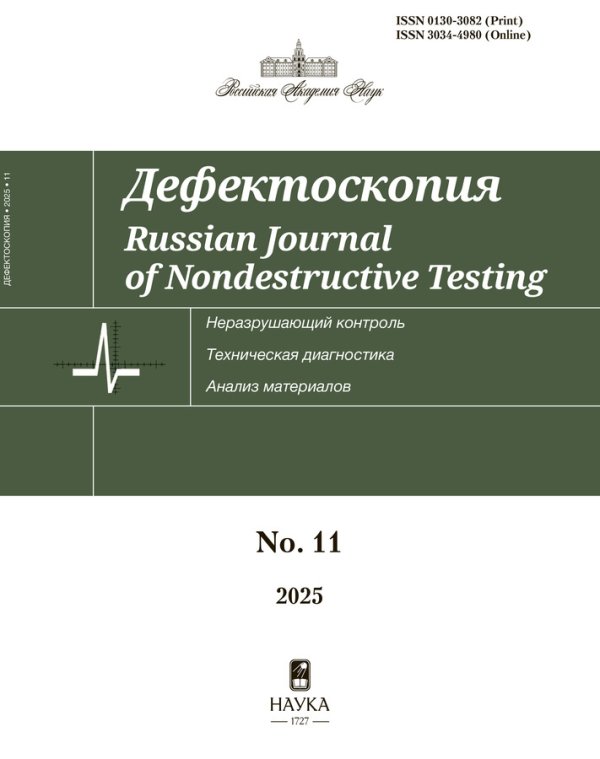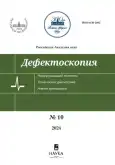Использование объемных отражателей для настройки параметров ультразвукового контроля
- Авторы: Могильнер Л.Ю.1, Смородинский Я.Г.2, Тишкин В.В.1
-
Учреждения:
- Московский государственный технический университет имени Н.Э. Баумана
- Институт физики металлов имени М.Н. Михеева УрО РАН
- Выпуск: № 10 (2024)
- Страницы: 3-15
- Раздел: Акустические методы
- URL: https://vestnik.nvsu.ru/0130-3082/article/view/649298
- DOI: https://doi.org/10.31857/S0130308224100014
- ID: 649298
Цитировать
Полный текст
Аннотация
В ультразвуковой дефектоскопии для настройки и проверки параметров оборудования традиционно используются боковые цилиндрические сверления. Другие объемные отражатели, например, вертикальные сверления или сферические поры, применяются редко. В настоящей статье отмечено, что объемные отражатели различных типов удобны для использования в качестве модели внутренних и выходящих на поверхность дефектов сварных швов. Тем более, что сверления различной ориентации просты в изготовлении. Долгое время ограничения применения сверлений для моделирования в ультразвуковой дефектоскопии были связаны с шумами, возникающими за счет дифракционных эффектов обегания цилиндрических полостей упругими волнами. Отмечено, что в настоящее время эти эффекты хорошо изучены. Их можно использовать для идентификации типа дефектов и измерения их размеров. В статье описаны результаты экспериментов по наблюдению рассеяния на цилиндрах и сферах продольных волн и поперечных волн с различной поляризацией, приведены характерные примеры проявления и использования указанных дифракционных эффектов. Также отмечена целесообразность использования не только сверлений, но и сферических пор. Эксперименты с рассеянием ультразвуковых волн на порах для наглядности выполнены на образцах из светопрозрачного стекла. Приведены сравнительные данные, показывающие, как дифракционные эффекты проявляются на различных объемных полостях. В том числе отмечено, что имеет место фокусировка сигналов, огибающих сферические поры. Отмечены ограничения на длительность импульсов ультразвуковых волн, при которых дифракционные сигналы можно использовать для повышения информативности при выявлении дефектов. Рекомендовано расширить применение боковых сверлений диаметром 2 мм в образцах для настройки чувствительности при ультразвуковом контроле эхометодом.
Полный текст
Об авторах
Л. Ю. Могильнер
Московский государственный технический университет имени Н.Э. Баумана
Автор, ответственный за переписку.
Email: mogilner@mail.ru
Россия, Москва
Я. Г. Смородинский
Институт физики металлов имени М.Н. Михеева УрО РАН
Email: sm@imp.uran.ru
Россия, Екатеринбург
В. В. Тишкин
Московский государственный технический университет имени Н.Э. Баумана
Email: mogilner@mail.ru
Россия, Москва
Список литературы
- Ермолов И.Н. Теория и практика ультразвукового контроля. М.: Машиностроение, 1981. С. 240.
- ГОСТ Р 55724—2013. Контроль неразрушающий. Соединения сварные. Методы ультразвуковые
- ISO 7963. Non-destructive testing — Ultrasonic examination — Specification for calibration block No. 2.
- Тютекин В.В. Рассеяние плоских волн цилиндрической полостью в изотропной упругой среде // Акустический журнал. 1959. Т. 5. № 1. С. 106—110.
- Голубев А.С. Отражение плоских волн от цилиндрического дефекта // Акустический журнал. 1961. Т. 7. Вып. 2. С. 174—180.
- Алешин Н.П., Могильнер Л.Ю. Анализ упругого поля ультразвуковых волн, рассеянных на цилиндрической полости // Дефектоскопия. 1982. № 12. С. 18—30.
- Могильнер Л.Ю. Применение цилиндрического отражателя для настройки чувствительности при ультразвуковом контроле // Дефектоскопия. 2018. № 7. С. 27—36.
- Гинзел Э. TOFD. Дифракционно-временной метод ультразвуковой дефектоскопии. М.: ДПК Пресс, 2021. С. 312. (Ed. Ginzel. Ultrasonic Time of Flight Diffraction. Waterloo, Ontario, Canada: Eclipse Scientific, 2013. 249 p.).
- Могильнер Л.Ю., Смородинский Я.Г. Ультразвуковой контроль: применение цилиндрического сверления для настройки и поверки оборудования // Дефектоскопия. 2018. № 9. С. 14—20.
- Ермолов И.Н. Жизнь и дефектоскопические истории. М.: Спектр, 2011. 120 с.
- Мелешко Н.В., Петров А.А. Зарубка и боковое цилиндрическое сверления. Режим доступа: https://www.shearwave.ru, запись от 11.08.2013. Дата обращения 26.07.2024.
- Базулин Е.Г., Вопилкин А.Х., Сухоруков Н.И., Тихонов Д.С. Анализ фазы ЦФА-изображений с целью определения типа обнаруженного отражателя // Дефектоскопия. 2019. № 7. С. 20—29.
- Данилов В.Н. О возможности оценки радиуса цилиндрического отражателя по времени запаздывания импульса волны обегания по отношению к зеркально отраженному импульсу поперечной волны при ультразвуковом контроле металла наклонным преобразователем // Контроль. Диагностика. 2024. Т. 27. № 3. С. 14—22.
- Могильнер Л.Ю., Сясько В.А., Шихов А.И. Моделирование дефектов в ультразвуковой дефектоскопии. Состояние и перспективы // Дефектоскопия. 2024. № 5. С. 13—35.
- Яворская И.М. Коротковолновая асимптотика дифракционного поля на сфере при падении плоских поперечных волн // Прикладная математика и механика. 1965. Т. 29. № 6. С. 1023—1034.
- Miklowitz J. The theory of elastic waves and waveguides. Amsterdam—New York—Oxford: North-Holland Publishing Company, 1978. 618 p.
- Алешин Н.П. Разработка теории, создание и внедрение методов и средств ультразвуковой дефектоскопии сварных соединений строительных конструкций / Автореферат дисс. д.т.н. Диссертация на соискание ученой степени доктора технических наук. М.: МВТУ им. Н.Э. Баумана, 1983. 32 с.
- Могильнер Л.Ю. Рассеяние ультразвуковых колебаний объемными моделями дефектов и разработка методики и средств неразрушающего контроля сварных узлов строительных структурных покрытий: диссертация на соискание ученой степени кандидата технических наук / Автореферат диссертации к.т.н. М.: МВТУ им. Н.Э. Баумана, 1983. 16 с.
- Яворская И.М. Дифракция плоской продольной волны на круглом цилиндре // Доклады АН СССР. 1964. Т. 158. № 6. С. 1287—1290.
- Яворская И.М. Дифракция плоских стационарных упругих волн на гладких выпуклых цилиндрах // Прикладная математика и механика. 1965. Т. 29. № 3. С. 493—508.
- Алешин Н.П., Баранов В.Ю., Могильнер Л.Ю., Яровой А.А. Повышение выявляемости объемных дефектов // Дефектоскопия. 1985. № 7. С. 24—30.
Дополнительные файлы



















